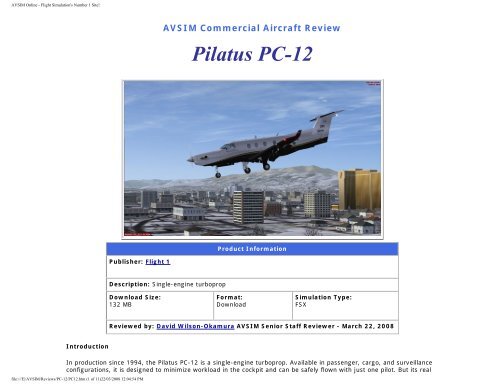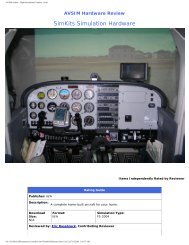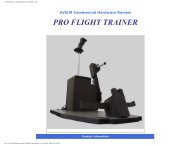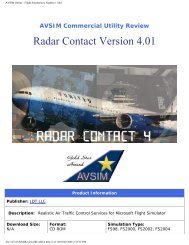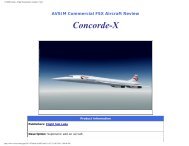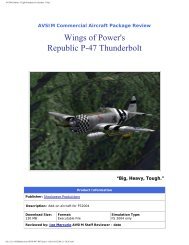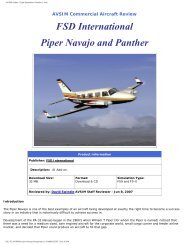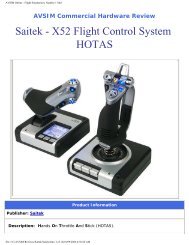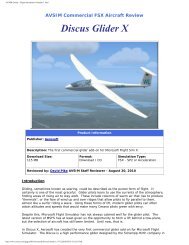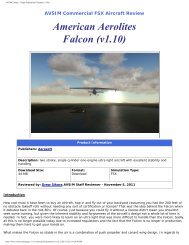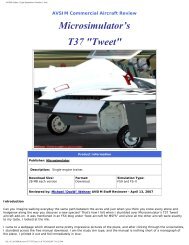Create successful ePaper yourself
Turn your PDF publications into a flip-book with our unique Google optimized e-Paper software.
<strong>AVSIM</strong> <strong>Online</strong> - Flight Simulation's Number 1 Site!<br />
Introduction<br />
Publisher: Flight 1<br />
<strong>AVSIM</strong> Commercial Aircraft Review<br />
Description: Single-engine turboprop<br />
Download Size:<br />
132 MB<br />
<strong>Pilatus</strong> <strong>PC</strong>-<strong>12</strong><br />
Product Information<br />
Format:<br />
Download<br />
Simulation Type:<br />
FSX<br />
Reviewed by: David Wilson-Okamura <strong>AVSIM</strong> Senior Staff Reviewer - March 22, 2008<br />
In production since 1994, the <strong>Pilatus</strong> <strong>PC</strong>-<strong>12</strong> is a single-engine turboprop. Available in passenger, cargo, and surveillance<br />
configurations, it is designed to minimize workload in the cockpit and can be safely flown with just one pilot. But its real<br />
file:///E|/<strong>AVSIM</strong>/Reviews/<strong>PC</strong>-<strong>12</strong>/<strong>PC</strong><strong>12</strong>.htm (1 of 11)22/03/2008 <strong>12</strong>:04:54 PM
<strong>AVSIM</strong> <strong>Online</strong> - Flight Simulation's Number 1 Site!<br />
claim to fame, as the “Swiss Army knife of general aviation,” is a combination of long range (2,200 nm) with short field<br />
capabilities. It can climb to FL300, cruise at 270 KIAS, and (under the right conditions) land on a runway as short as<br />
1,000 feet. In isolation, none of those numbers are record-setters. A jet, for example, will take you there faster, so long<br />
as there’s enough runway at your destination. A bush plane, like the De Havilland Beaver, can land in shorter differences<br />
on more surfaces, but it won’t fly as high or as fast.<br />
This is Flight1’s second version of the <strong>PC</strong>-<strong>12</strong>. Their first version, for FS2004, was endorsed by <strong>Pilatus</strong> and distributed to<br />
potential buyers of the real airplane. I flew scores of hours in the FS2004 product, and was eager to see how it would<br />
perform in FSX. I am pleased to report that the new version is every bit as satisfying and fun to fly as the old one. For<br />
someone who wants to step up from one of the default aircraft, this is a good choice: it looks good (inside and out), it’s<br />
easy to operate, and you won’t get tired of flying it.<br />
Installation and Documentation<br />
This product was developed in-house by Flight1 and uses the familiar Flight1<br />
wrapper. Installation is straightforward, as is the initial configuration (which you<br />
can change later).<br />
The download version, which I am reviewing, comes with three manuals: one for<br />
the Garmin 430 GPS, one for the Garmin MX200 multi-function display, and a<br />
pilot’s handbook. All three are well illustrated, and the pilot’s handbook includes<br />
graphs and charts for performance calculations, as well as the standard<br />
checklists.<br />
Missing from the package are a tutorial for the autopilot (which was included in<br />
the FS2004 version), kneeboard checklists, and kneeboard reference numbers.<br />
The first omission won’t be noticed by anyone who didn’t already own the FS2004 version, but the other two are<br />
inexplicable.<br />
Exterior Views<br />
The visual model is all-new for FSX. I didn’t notice any differences in the silhouette, but the reflections are more<br />
convincing, and bump-mapping has been used selectively to give surfaces more texture. In spot plane view, I found<br />
myself staring at the skin a lot, mesmerized by the illusion of depth.<br />
file:///E|/<strong>AVSIM</strong>/Reviews/<strong>PC</strong>-<strong>12</strong>/<strong>PC</strong><strong>12</strong>.htm (2 of 11)22/03/2008 <strong>12</strong>:04:54 PM
<strong>AVSIM</strong> <strong>Online</strong> - Flight Simulation's Number 1 Site!<br />
A downside of the new model is that old repaints don’t work anymore; this includes two of my favorite liveries from the<br />
original package, the red and black “Expertise” paint scheme and a midnight blue stars scheme. On the plus side, there<br />
are several new liveries to replace the old and, because the visual model is native to FSX, the propeller does not<br />
disappear in front of clouds. There is also a paint kit.<br />
file:///E|/<strong>AVSIM</strong>/Reviews/<strong>PC</strong>-<strong>12</strong>/<strong>PC</strong><strong>12</strong>.htm (3 of 11)22/03/2008 <strong>12</strong>:04:54 PM<br />
Colorful liveries
<strong>AVSIM</strong> <strong>Online</strong> - Flight Simulation's Number 1 Site!<br />
All of the standard animations are here, and all of them are smooth. With the previous version, you could make the<br />
pilots put on their sunglasses by pressing the spoiler key; that animation is gone now, but it was never more than a<br />
gimmick anyway and I’d rather see the resources used for more substantial things -- as they are here.<br />
Pylons and red carpet<br />
Bottom line? To my eye, the silhouette of the real <strong>PC</strong>-<strong>12</strong> is not destined to be a classic. It looks alright head-on (and that<br />
is how, in Flying magazine, it always seems to be photographed), but in profile there is something off in the proportions.<br />
Our concern here, though, is not with the profile itself, but the rendering of that profile in pixels and polygons; that is<br />
superb.<br />
Cockpit<br />
There are some new gauges (which I’ll discuss in a minute), but the environment of the virtual cockpit is largely<br />
unchanged -- meaning, it is still world-class.<br />
Virtual cockpit<br />
Modeling is smooth and textures are ultra-sharp, even when viewed up close. This is particularly noticeable for text: you<br />
can even read the serial number on the cockpit window.<br />
file:///E|/<strong>AVSIM</strong>/Reviews/<strong>PC</strong>-<strong>12</strong>/<strong>PC</strong><strong>12</strong>.htm (4 of 11)22/03/2008 <strong>12</strong>:04:54 PM
<strong>AVSIM</strong> <strong>Online</strong> - Flight Simulation's Number 1 Site!<br />
Sharp textures<br />
There’re no dirt or wear marks, but there are signs of life in the cockpit: a chart open on the copilot’s seat, a can of soda<br />
in the PIC’s cup holder.<br />
For that lived-in look<br />
The sunshades are fixed in place now, and can no longer be dragged down to reduce glare in the cockpit (as they could<br />
be in FS2004). But since glare isn’t much of a problem in the simulator, moving sunshades were more of a novelty than<br />
anything else, and their absence in the new version is not really missed.<br />
file:///E|/<strong>AVSIM</strong>/Reviews/<strong>PC</strong>-<strong>12</strong>/<strong>PC</strong><strong>12</strong>.htm (5 of 11)22/03/2008 <strong>12</strong>:04:54 PM
<strong>AVSIM</strong> <strong>Online</strong> - Flight Simulation's Number 1 Site!<br />
Passenger cabin<br />
Cargo cabin<br />
Behind the flight deck there is a virtual cabin, the contents of which vary depending on which model of <strong>PC</strong>-<strong>12</strong> you are<br />
flying: passenger, cargo, executive transport, or surveillance. Textures in the cabin are not as sharp as in the cockpit,<br />
but since the cockpit is where we spend most of our time in the simulator, that is not surprising. Cabin alerts (“No<br />
Smoking” and “Fasten Your Seatbelts”) can be turned on and off in the cockpit, but that is the only place you will see<br />
them.<br />
The <strong>PC</strong>-<strong>12</strong> is meant to be flyable by one pilot. Seat and gauges are provided for a copilot, but there’s enough automation<br />
that one pilot can handle the workload. One thing that helps is gauge design. For example, the artificial horizon gauge<br />
also displays rate of turn, radar altitude, decision height, compass heading, heading bug indicator, autopilot status,<br />
glideslope, and angle of attack (AOA). This last item will be familiar to jet pilots, but perhaps not to GA pilots.<br />
When you are on final, the AOA computer will calculate your best approach speed, taking into account the weight of your<br />
plane and the angle of your flaps. If the speed pointer dips toward “S” you’re going too slow, and if it nods up toward “F”<br />
you’re going too fast. For ILS approaches, the same gauge also displays a so-called rising runway that increases in size<br />
as you get closer (and also shows whether you are centered for the approach). Is this confusing? It can be, but once you<br />
understand what you’re looking at, the presentation of information is very efficient. This is especially useful in the last<br />
seconds before touchdown, when you don’t want to divide your attention between different gauges.<br />
file:///E|/<strong>AVSIM</strong>/Reviews/<strong>PC</strong>-<strong>12</strong>/<strong>PC</strong><strong>12</strong>.htm (6 of 11)22/03/2008 <strong>12</strong>:04:54 PM
<strong>AVSIM</strong> <strong>Online</strong> - Flight Simulation's Number 1 Site!<br />
New comm radios Centering the speed needle VC pop-ups<br />
There is one feature that the virtual <strong>PC</strong>-<strong>12</strong> has that the real <strong>PC</strong>-<strong>12</strong> does not have: airspeed hold. I tried this, but didn’t<br />
end up using it much, because it’s really an autothrottle hold. This is useful in jets, where keeping your speed down at<br />
low altitudes can be a challenge.<br />
In the <strong>PC</strong>-<strong>12</strong>, it would be useful if you could keep the throttle open and set the<br />
airspeed hold for best rate of climb, but that doesn’t work because to lower your<br />
airspeed the autothrottle reduces power, and this results in rather anemic climb<br />
rates. There is one other problem with the airspeed indicator: whether you<br />
enable airspeed hold or not, the airspeed indicator is too dark to read at night,<br />
even with cockpit lighting.<br />
Most of the <strong>PC</strong>-<strong>12</strong>’s cockpit functionality was already present in the FS2004<br />
version. For FSX, there are improved map and arc views on the horizontal<br />
situation indicator, and the comm radios have been upgraded. (The new radios<br />
look nicer, but the real benefit is that now you can listen to two radios at the Airspeed indicator is invisible at night<br />
same time; that wasn’t possible in the FS2004 version.) There is also a new<br />
transponder, GTX 337, which (in addition to broadcasting a four-digit transponder code) can also display altitude, outside<br />
air temperature, density altitude, a count-up timer, and flight time.<br />
What most users of the previous version are going to notice, though, is the GPS<br />
upgrade. Older <strong>PC</strong>-<strong>12</strong>s, on which the FS2004 was based, came equipped with a<br />
Bendix/King KLN-90B. This was a bit primitive, even by the standards of a few<br />
years ago, and Flight1’s implementation of it did not include a moving map. (A<br />
more complete version of the KLN-90B is available from gauge modeler Don<br />
Kuhn, who sells his own version of the <strong>PC</strong>-<strong>12</strong> cockpit and also has licensed his<br />
GPS gauge for use in Aerosoft’s Twin Otter package.)<br />
Flight1’s new version of the <strong>PC</strong>-<strong>12</strong> does away with the Bendix/King GPS in favor<br />
of two Garmin 430 units and a Garmin MX200 multifunction display. All three<br />
GPS upgrades<br />
units have an interface similar to the Garmin 500 GPS that comes standard with<br />
Flight Simulator, so if you already know how to use the default GPS you can<br />
learn the new ones with almost no effort.<br />
The main difference is that Garmin 430 units also control your nav radios; also, none of the GPS units can use the<br />
keyboard. This is annoying, but with a little practice it is possible to do what you want doing the mouse. Again, the<br />
implementation is partial; for example, while the real Garmin 430 can calculate the vertical rate of descent that you will<br />
file:///E|/<strong>AVSIM</strong>/Reviews/<strong>PC</strong>-<strong>12</strong>/<strong>PC</strong><strong>12</strong>.htm (7 of 11)22/03/2008 <strong>12</strong>:04:54 PM
<strong>AVSIM</strong> <strong>Online</strong> - Flight Simulation's Number 1 Site!<br />
need to cross a given waypoint at a given altitude, the simulated one can’t. (It looks like it can, but that’s an illusion.) It<br />
also can’t display an estimated time of arrival (ETA) for the active flight plan, or help with fuel planning. The result?<br />
While the new version has better GPS hardware than the old one, it’s not quite as functional or easy to use as the new<br />
Garmin 1000 that comes with the deluxe version of FSX.<br />
Flight1’s version of the <strong>PC</strong>-<strong>12</strong> is a joy to fly from the virtual cockpit, especially if<br />
you have TrackIR. But there is also a full 2D cockpit, and pop-up versions of the<br />
main gauges in the virtual cockpit. You can’t use the keyboard to set the<br />
autopilot altitude, which means that you also can’t assign this function to one of<br />
your controller buttons. But other than that, workflow in the cockpit is extremely<br />
efficient.<br />
Sound<br />
Sounds are unchanged from the original product for FS2004. The mechanical<br />
sounds (of gear, flaps, and engine) are all factory fresh; you will notice nuances,<br />
Full 2D cockpit<br />
but they’re part of a sequence, not the results of age and use. What I think<br />
most pilots are going to notice more than the mechanical sounds are the various warning and caution sounds, especially<br />
the emergency warnings, which are issued by a recorded voice. What the voice says depends on which language you<br />
select in the configuration manager; you can choose from French, German, Spanish, or British-accented English.<br />
Flight Model<br />
I am not a real-life pilot, of <strong>PC</strong>-<strong>12</strong>'s or anything else, so what I have to say about the flight model will necessarily be<br />
impressionistic. First, a one-and-only negative: the engine, when first started, surges to maximum, so that if you are<br />
parked with the nose facing a building, you will probably run into it. I am prepared to believe that this was an intentional<br />
compromise, so that engine performance in the air would be more realistic. Still, I would welcome a workaround.<br />
The <strong>PC</strong>-<strong>12</strong> is powered by a single Pratt & Whitney PT6; unlike some engines, the PT6 does not exhibit the long lag<br />
between throttle inputs and power outputs that we associate with turboprops. This behavior is reflected in the model,<br />
and makes the <strong>PC</strong>-<strong>12</strong> easier to manage at low speeds than most other turboprops.<br />
file:///E|/<strong>AVSIM</strong>/Reviews/<strong>PC</strong>-<strong>12</strong>/<strong>PC</strong><strong>12</strong>.htm (8 of 11)22/03/2008 <strong>12</strong>:04:54 PM
<strong>AVSIM</strong> <strong>Online</strong> - Flight Simulation's Number 1 Site!<br />
With flaps extended, the nose of the <strong>PC</strong>-<strong>12</strong> tends to pitch down, which (from what I have read) is entirely realistic; it<br />
also gives the pilot a good view of the landing field. The real-world <strong>PC</strong>-<strong>12</strong> can’t drop quite as fast a <strong>Pilatus</strong> Porter or De<br />
Havilland Beaver, but it is capable of some very rapid descents, and that behavior is in evidence here. With flaps fully<br />
extended, the <strong>PC</strong>-<strong>12</strong> is supposed to hold 63 KIAS without stalling; a low landing speed keeps the landing distance down<br />
and, again, the model matches the specification.<br />
Performance<br />
In the three months that this product has been available, I have yet to hear anyone<br />
complain about its frame rates. In the configuration manager, it is possible to turn off<br />
the copilot gauges in order to improve frame rates., but the difference (in my<br />
experience) is not very large. Depending on weather and other variables, you will<br />
notice a frame rate hit relative to the defaults. But it’s not a sizable one, and once in<br />
the air I rarely noticed it.<br />
Conclusion<br />
The <strong>Pilatus</strong> <strong>PC</strong>-<strong>12</strong> for FSX sells for $33 (US), with a $10 discount for owners of the<br />
FS2004 version. It’s been several months now since I actually flew anything in FS2004,<br />
but when I did, this aircraft was one of my favorites.<br />
On VATSIM, I flew it up, down, and across the western coast of North America more<br />
times than I can remember. In Papua New Guinea, I used it to explore the whole<br />
mountainous island, as well as the surrounding archipelago.<br />
The <strong>PC</strong>-<strong>12</strong> is flexible, fast, forgiving, easy to fly, and looks great in the virtual cockpit.<br />
The FSX version is just as good, and in some areas (avionics and exterior views), even<br />
better than its successful predecessor. I’m glad to have it back in my hangar.<br />
file:///E|/<strong>AVSIM</strong>/Reviews/<strong>PC</strong>-<strong>12</strong>/<strong>PC</strong><strong>12</strong>.htm (9 of 11)22/03/2008 <strong>12</strong>:04:54 PM<br />
What I Like About The <strong>Pilatus</strong> <strong>PC</strong>-<strong>12</strong> for FSX<br />
Test System<br />
Core2Duo E6600 @ 2.4 GHz<br />
4 gigabytes RAM<br />
Nvidia 8800 GT (5<strong>12</strong> Mb)<br />
Samsung 20” widescreen LCD<br />
(1680 x 1050)<br />
Windows XP Pro SP2<br />
TrackIR 3 with Vector<br />
Expansion<br />
CH pedals, yoke<br />
Saitek X45 throttle<br />
Sidewinder Precision Pro<br />
joystick<br />
Buttkicker Gamer<br />
Flying Time:<br />
25 hours
<strong>AVSIM</strong> <strong>Online</strong> - Flight Simulation's Number 1 Site!<br />
● Visual model has been completely overhauled for FSX and makes good use of new<br />
features.<br />
● Upgraded avionics<br />
● Not a frame rate hog<br />
● Modern aircraft that’s fun to fly, easy to manage<br />
What I Don't Like About The <strong>Pilatus</strong> <strong>PC</strong>-<strong>12</strong> for FSX<br />
● I would have liked a more functional simulation of the Garmin 430 GPS (e.g., help with<br />
fuel planning, VNAV calculations, and ETA).<br />
● At night, airspeed indicator is too dark to read.<br />
Printing<br />
If you wish to print this review or read it offline at your leisure, right click on the link below,<br />
and select "save as"<br />
<strong>Pilatus</strong> <strong>PC</strong>-<strong>12</strong> for FSX<br />
(adobe acrobat required)<br />
Comments?<br />
Standard Disclaimer<br />
The review above is a subjective assessment of the product by the author. There is no connection between<br />
the producer and the reviewer, and we feel this review is unbiased and truly reflects the performance of<br />
the product in the simming environment. This disclaimer is posted here in order to provide you with<br />
background information on the reviewer and any connections that may exist between him/her and the<br />
contributing party.<br />
Tell A Friend About this Review!<br />
© 2008 - <strong>AVSIM</strong> <strong>Online</strong><br />
All Rights Reserved<br />
Powered by <strong>AVSIM</strong> SimWords Become a SimWord Publisher!<br />
file:///E|/<strong>AVSIM</strong>/Reviews/<strong>PC</strong>-<strong>12</strong>/<strong>PC</strong><strong>12</strong>.htm (10 of 11)22/03/2008 <strong>12</strong>:04:54 PM
<strong>AVSIM</strong> <strong>Online</strong> - Flight Simulation's Number 1 Site!<br />
<strong>AVSIM</strong> Reviews<br />
Want to stay on top of the most<br />
recent ad ons? See our Reviews!<br />
www.avsim.com<br />
file:///E|/<strong>AVSIM</strong>/Reviews/<strong>PC</strong>-<strong>12</strong>/<strong>PC</strong><strong>12</strong>.htm (11 of 11)22/03/2008 <strong>12</strong>:04:54 PM<br />
Advertise Here!<br />
Want your advertising to count?<br />
Advertise in this slot for pennies a<br />
day!<br />
www.avsim.com<br />
VRS F/A-18E 'Superbug'<br />
The VRS F/A-18E "Superbug" for<br />
MSFS 2004/FSX is the most<br />
advanced combat add-on aircraft<br />
ever created for the FS platform!<br />
Vertical Reality Simulations<br />
Make Money with SimWords!<br />
Join the ranks of websites earning<br />
an income from SimWords.<br />
Become a Publisher today!<br />
www.avsim.com<br />
FlightSimX<br />
Daily flight simulator news, views<br />
and reviews<br />
www.flightsimx.co.uk


